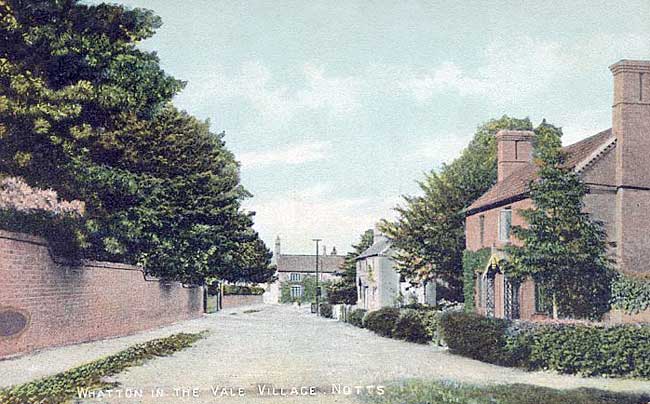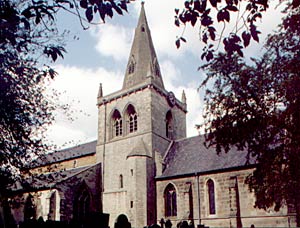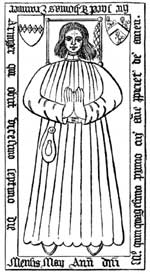< Previous | Contents | Next >
The Butterfly on the Belt
WHATTON-IN-THE-VALE. The last resting-place of a man whose famous son died bravely at the stake is this pretty village, where houses with tall chimney stacks are scattered about a network of roads. It stands on the River Smite, crossed by a wooden bridge not far from a church which is famed for its monuments.

Church Street, Whatton-in-the-Vale, c.1910.

Whatton church (2001).
Alterations last century included the rebuilding of the chancel and of the central tower with its sturdy spire. A transept was destroyed, and the Norman arch once on the south side of the tower is now on the north, hidden by the organ but seen outside. From about 1300 come the north porch, the inner doorway, and the nave arcades. The double piscina is medieval, and the font is 17th century.
The east window of the south aisle is a fine frame for glass by William Morris and Burne-Jones, with figures of Our Lord, Peter, and John, on heavy backgrounds of orange tree, flowering rosebush, and pomegranates. Below them are scenes of Jesus making the blind to see, the lame to walk, and raising the dead. The east window of the other aisle, showing Our Lord ascending in a company of angels with Mary and the Disciples below, is in memory of Thomas Dickinson Hall, who last century rebuilt some of the farms and cottages and built Whatton Manor, a charming house in Elizabethan style standing amid beautiful plantations on the edge of the village.
Part of the church was once used as a school, and the splendid monument of Sir Hugh de Newmarch of about 1400, defaced with innumerable names and initials, bears ample evidence of that time. He lies on a tomb with 20 shields, an alabaster knight in chain mail and SS collar, one leg missing and one half of the other foot left to rest on a lion. His worn belt must once have been fine, for one of the medallions has carving as fresh as the day it was done, and has on it a kind of butterfly with wings spread out like fans, and a quaint and vivid face. It is a little gem worth finding.

Floorstone of Thomas Cramner senior (died 1501).
In a restored recess of the north aisle lies the stone figure of Robert de Whatton, who was vicar here from 1304; his hands are at prayer, and he wears the simple dress of a canon of Welbeck Abbey. Sir Richard de Whatton of 1322, with his legs crossed and wearing chain mail, lies on a splendid stone tomb with shields.
Very fine is an alabaster floorstone with the engraved portrait of a man with flowing hair, wearing a long gown with a purse. It is the most stirring of all Whatton's possessions, for it is the portrait of Thomas Cranmer of 1501, who doubtless brought his famous son to worship in this church before he grew up to be Archbishop of Canterbury and to die for his faith. Born at Aslockton close by, the Archbishop is said to have loved to listen to Whatton's tuneful bells.
Other old relics are a richly carved founder's recess with ball-flowers, battered now and without a tenant; and the head of the old village cross which was found last century in a cottage wall at Aslockton. It is elaborately carved with figures of Peter and Paul, St James with two others, and Our Lord with Mary and John.
